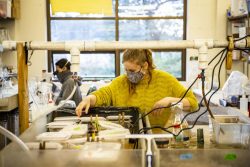
Just a few days shy of the first day of spring, scientists at Friday Harbor Laboratories on San Juan Island had reason to celebrate.
Dozens of juvenile sea stars, no bigger than a poppy seed, had successfully metamorphosed from floating larvae to mini star — the important first step toward becoming an adult. Between now and then, these sunflower sea stars, the largest sea star species in the world, will grow up to 24 arms and a colorful body the size of a serving platter.
These young animals represent the first attempt to raise sunflower sea stars in captivity. The species, once abundant from Alaska to Southern California, was nearly destroyed by a mysterious wasting disease that has affected many sea stars in the ocean, but none so catastrophic as the sunflower star. In December, the species was listed as critically endangered by the International Union for Conservation of Nature, prompting a new focus on recovery efforts — including captive breeding.
The project, a partnership between the University of Washington and The Nature Conservancy, aims to learn more about sunflower sea stars and explore eventual reintroduction to the wild, if determined to be advisable. The research team currently is raising sea stars in several phases of development, including newly born larvae, mini juveniles and fully grown adults.
“What we’re attempting to do here is to raise a new generation of sea stars in the lab,” said Jason Hodin, research scientist at Friday Harbor Labs who is leading the captive rearing efforts for the UW. “We’re hoping that our efforts can help in the process of recovery of the sunflower sea star and, ultimately, recovery of the health of ecosystems like the kelp forests that are under threat right now.”
Read more at UW News »
